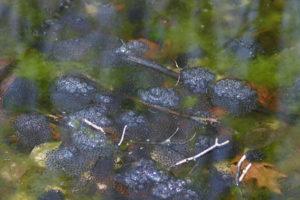As I have mentioned in previous posts, wetlands around the world are disappearing, in part because of land use changes and climate change. We should all be concerned about these losses because wetlands provide a number of ecosystem services that benefit us all, services like water filtration, vital wildlife habitat, carbon sequestration (in the peat), and flood mitigation. Are there ways to slow and even reverse these losses? Yes, and although we have yet to figure out all of the pieces of the puzzle, we’ve got some good ideas about what does (and does not) work.
Quite a bit of research has been done to help prioritize conservation efforts by indicating which wetlands are at greatest risk. The threat to a wetland increases with proximity to development and roads, and that risk is intensified by the size of the development or roadway (Gutzwiller and Flather 2011), which makes sense because that means that more people are using the area. Unfortunately, a 2011 study (Wardrop et al. 2011) in the Appalachians found that areas with the highest rates of population growth were not generally places with wetland conservation efforts, so those wetlands most likely to be suggested for development were also less likely to have people watching out for them. In flatter areas of the planet, we know that prairie wetlands are at greater risk as farming continues to change from smaller, more diverse farms to larger, more intensive agriculture (Doherty et al. 2013), and Bartzen et al. (2010) suggested prioritizing conservation of those pristine wetlands which still exist because, once impacted, they were not expected to fully recover.

These wood frog eggs were laid in an ephemeral pool because ponds with year-round water provide habitat to bull frogs and other animals that will eat frog eggs. Photo courtesy of Connecticutbirder- license
What if we have already lost the wetlands we need? There are some options for created wetlands, but we need to really pay attention to the details. One thing we need to ask ourselves is exactly what we want a created wetland to do– are we interested in wildlife habitat or nutrient storage? Do we want flood control or carbon sequestration? A study of wastewater wetlands (yes, that means creating wetlands at wastewater treatment plants- and they are nothing to sneeze at- there’s even one in Australia that is listed with the Ramsar Convention!) indicated that large, shallow ponds which benefit birds and invertebrates are good for nitrogen storage, but not phosphorus storage (Murray and Hamilton 2010). We can just dig out an area and divert a water source into it and a wetland of sorts will develop over time, but there’s a bit more to the science than simply saturating the ground. A long-term study in Ohio which compared the plant diversity of created wetlands over 15 years found that, when left to their own devices, wetland plants will colonize the area, but the overall plant diversity is higher with targeted plantings of specific species (Mitsch et al. 2012). And getting the hydrology right is hugely important– created wetlands in Kentucky were originally designed to have water year-round, which is great for animals like bullfrogs (Denton and Richter 2013). Wetlands that don’t dry out for at least part of the year are no good, however, for animals like marbled salamanders which breed in ephemeral pools too short-lived for larger predatory amphibians- they need ponds that disappear so that their eggs and young have a safe place to develop.
So the first goal is to protect the wetlands we have, and the second is to create the additional wetlands we need by considering all of the things that wetlands do and then trying to recreate those conditions. How can we personally get involved with that? That’s what I’ll look into for my final post of the month.
Works cited:
Bartzen, B.A., K.W. Dufour, R.G. Clark, and F.D. Caswell. 2010. Trends in agricultural impact and recovery of wetlands in prairie Canada. Ecological Applications 20:525–538.
Denton, R.D., and S.C. Richter. 2013. Amphibian communities in natural and constructed ridge top wetlands with implications for wetland construction. The Journal of Wildlife Management 77:886–896.
Doherty, K.E., A.J. Ryba, C.L. Stemler, N.D. Niemuth, and W.A. Meeks. 2013. Conservation Planning in an Era of Change: State of the U.S. Prairie Pothole Region. Wildlife Society Bulletin 37:546–563.
Gutzwiller, K.J., and C.H. Flather. 2011. Wetland features and landscape context predict the risk of wetland habitat loss. Ecological Applications 21:968–982.
Mitsch, W.J., L. Zhang, K.C. Stefanik, A.M. Nahlik, C.J. Anderson, B. Bernal, M. Hernandez, and K. Song. 2012. Creating Wetlands: Primary Succession, Water Quality Changes, and Self-Design over 15 Years. BioScience 62:237–250.
Murray, C.G., and A.J. Hamilton. 2010. Perspectives on wastewater treatment wetlands and waterbird conservation. Journal of Applied Ecology 47:976–985.
Wardrop, D.H., A.K. Glasmeier, J. Peterson-Smith, D. Eckles, H. Ingram, and R.P. Brooks. 2011. Wetland ecosystem services and coupled socioeconomic benefits through conservation practices in the Appalachian Region. Ecological Applications 21:S93–S115.
